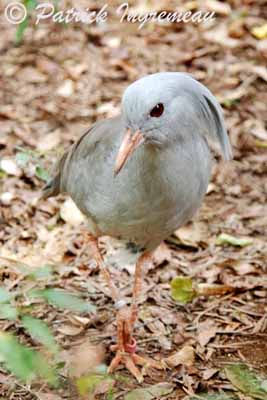
Kagu
Rhynochetos jubatus
Eurypygiforme Order - Rhynochétidae Family
BIOMETRICS :
Length: 55 cm ; Wingspan: 77 cm ; Weight: 700-1100 g
LONGEVITY: up to 20 years in captivity
DESCRIPTION:

Kagu is an endangered species, threatened by habitat loss and predation. It is endemic to New Caledonia.
Kagu has pale ash grey and white plumage overall. With closed wings, the bird appears pale grey. But if it opens its wings, we can see black and white bars in primaries, slightly over lined with brown, black and grey.
On the upper parts, wings and tail are slightly darker than rest of plumage.
Under parts are usually whitish with paler grey head, crest and breast.
On the head, we can see a long crest, which longest feathers reach the back. Long, powerful, reddish bill is narrow and measures about 60 mm. The nasal opening is covered with “flaps” to protect it from earth during probing. Kagu also shows numerous fine, downy rictal bristles at the base of the bill. Eyes are dark red and allow binocular vision.
Legs and feet are reddish as bill.
Female is similar, but she has more extensive striped pattern on the under wings than male.
Chick has cryptic plumage.
Juvenile resembles adults, but it has browner, finely barred plumage. Bill and legs are rather orange than red. It reaches the adult plumage at about 2 to 3 years.
VOICE: SOUNDS BY XENO-CANTO
Kagu utters various kinds of songs, and pairs form duets in the morning, during about 15 minutes.
Uttered sounds resemble bark of young dog and rooster crowing. Female has shorter and more rapid song than male.
Contact call, in order to locate each other, is a “gou gou gou gou…” These loud sounds are given before the song, but they are softer if used as contact calls.
HABITAT:
Kagu live in dense mountain forests, but now, it has restricted range, and lives under human protection. It can frequent wet and tall shrubland, from sea-level up to 1400 metres of elevation. This species is usually found in areas where food resources are abundant.
RANGE:
Kagu is endemic to New Caledonia, and resident in its range. Birds only perform some movements within territory, according to food resources.
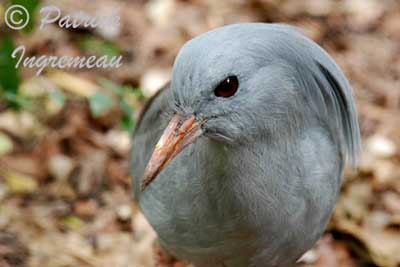
BEHAVIOUR:
Kagu feeds by probing with its bill into various kinds of soils and in leaf litter. It also catches preys in fresh shallow water at pool’s edges.
Kagu feeds as a heron, standing motionless on one foot, watching for preys. It may use its free leg for brushing the litter in order to flush preys. It may use its bill in the same way. It can detect prey by sound, thanks to its keen hearing. It is a diurnal feeder.
Body weight varies from 700 to 1100 grams according to the elevation and the season.
Kagu pair has permanent territory, and birds defend it all year round. Disputes can occur, involving contact fights with bill and wings. Usually, there is not serious injury.
Threats displays show the adult with open wings, in order to display the barred under wing pattern. If the threat display is used in defence of nest and chicks, the adult will flap its open wings, and perform distraction display such as “broken wing”. While Kagu performs these displays, crest is partially erected. The under wing pattern is used as intimidation of large reptiles.
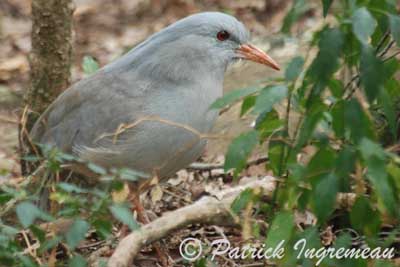
During courtship displays, birds use the wings for strutting. Both sexes have upright posture, with wings held down and forwards, as a cape, and circle each other. Under wing pattern is concealed, but the crest is completely raised and fanned.
Kagu often roost within their feeding area. Birds of the same pair can be solitary outside breeding season, and may sing or roost together sometimes. They have separated but overlapping feeding areas. At higher elevation, Kagus roost on the ground in sheltered place. Then, when temperatures are better, they can roost above the ground, often in low branches.
FLIGHT:
Kagu is flightless. It has correct wingspan, but it lacks the necessary musculature for sustained flights. It only uses its wings for helping some movements.
REPRODUCTION:
Kagus are monogamous and mate for life. Breeding period occurs between June and August, but some pairs can breed until December.
The nest-site is not especially concealed. Nest is often built against vegetation, tree trunk or old log. At higher altitude, it is often sheltered amongst rocks. Nest is a simple construction made with leaves, taken around the nest-site.
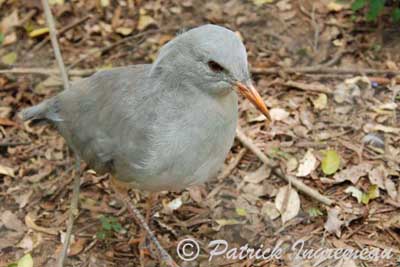
Female lays only one creamy-brown egg, with dark grey markings. Incubation lasts about 33 to 37 days, shared by both parents. Birds take turns every 24 hours. A ritual display consists of “leaf-tossing”, the bird which moves off the nest, carries out a leaf in the bill. At dawn, incubating bird joins its mate in order to perform their duets.
Semi-precocial chick moves from the nest at about three days of age. When at nest, it is brooded and fed by both parents. They are very patient with their chick when feeding it.
If threatened, the chick remains motionless, protected by its cryptic plumage, or it hides among vegetation.
The chick is brooded at night during six weeks. At about 8 to 10 weeks old, the young perches at night on fallen trunks. It is fed by parents until it reaches 14 weeks of age, and after this period, it becomes independent. The juvenile can remain in its natal territory for up to six years or more. Young male can breed at 2 years.
DIET:
Kagu feeds on the ground, by probing into leaf litter. It feeds on snails, millipedes, beetles, lizards and worms. Kagu is adepts for pulling worms from the soil, and usually gets it complete.
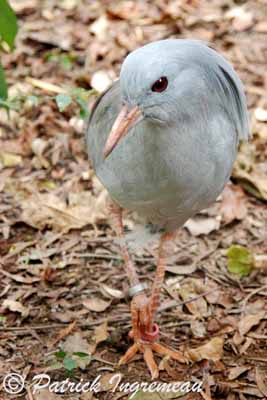
PROTECTION / THREATS / STATUS:
Kagu is an endangered species, fully protected in New Caledonia. It is threatened by cats and pigs, and mainly by dogs introduced by Captain Cook in 1774. Hunting was its initial decline with habitat loss.
It is very well protected and this species breeds well in the Noumea Zoo. It is also found in the protected Riviere Blue Park, a refuge especially managed for this species.
The future of this species is precarious, in spite of conservation programs, due to insufficient numbers of pairs.
In the wild, dogs are the most important threat for the Kagus.
Fr: Kagou huppé
All : Kagu
Esp : Kagú
Ital : Kagu
Nd : Kagoe
Russe : Кагу
Photos de Patrick Ingremeau
Son site : TAMANDUA
Texte de Nicole Bouglouan
Sources:
HANDBOOK OF THE BIRDS OF THE WORLD Volume 3 by Josep del Hoyo-Andrew Elliott-Jordi Sargatal - Lynx Edicions, 1996, 821 pages - ISBN: 8487334202
CREAGUS@Monterey Bay (Don Roberson)
Wikipedia (Wikipedia, The Free Encyclopedia)